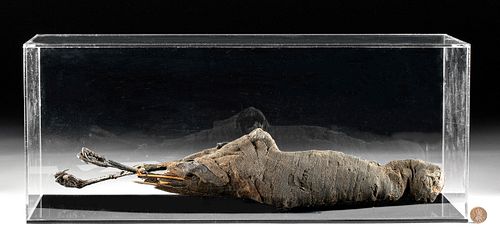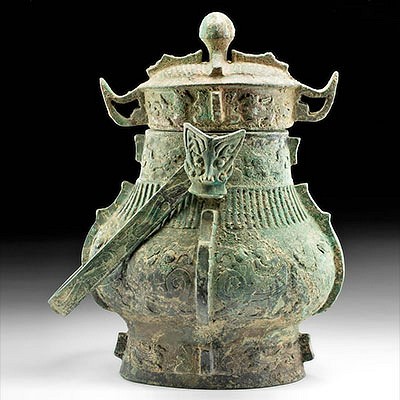Egyptian Late Period Mummified Falcon
Lot 1f
About Seller
Artemis Fine Arts
686 S Taylor Ave, Ste 106
Louisville, CO 80027
United States
Selling antiquities, ancient and ethnographic art online since 1993, Artemis Gallery specializes in Classical Antiquities (Egyptian, Greek, Roman, Near Eastern), Asian, Pre-Columbian, African / Tribal / Oceanographic art. Our extensive inventory includes pottery, stone, metal, wood, glass and textil...Read more
Estimate:
$4,000 - $6,000
Absentee vs Live bid
Two ways to bid:
- Leave a max absentee bid and the platform will bid on your behalf up to your maximum bid during the live auction.
- Bid live during the auction and your bids will be submitted real-time to the auctioneer.
Bid Increments
| Price | Bid Increment |
|---|---|
| $0 | $25 |
| $300 | $50 |
| $1,000 | $100 |
| $2,000 | $250 |
| $5,000 | $500 |
| $10,000 | $1,000 |
| $20,000 | $2,500 |
| $50,000 | $5,000 |
| $100,000 | $10,000 |
| $200,000 | $20,000 |
About Auction
By Artemis Fine Arts
Jul 1, 2020
Set Reminder
2020-07-01 10:00:00
2020-07-01 10:00:00
America/New_York
Bidsquare
Bidsquare : Ancient | Near-Eastern | Asian Art
https://www.bidsquare.com/auctions/artemis-gallery/ancient-near-eastern-asian-art-5276
Ancient art from Egypt, Greece, Italy and the Near East, as well as Asian, Fossils, Pre-Columbian, Native American, African / Tribal / Oceanic, Spanish Colonial, Russian Icons, Fine art, much more! Artemis Fine Arts info@artemisgallery.com
Ancient art from Egypt, Greece, Italy and the Near East, as well as Asian, Fossils, Pre-Columbian, Native American, African / Tribal / Oceanic, Spanish Colonial, Russian Icons, Fine art, much more! Artemis Fine Arts info@artemisgallery.com
- Lot Description
Egypt, Late Dynastic to Romano-Egyptian Period, ca. 664 BCE to 2nd century CE. A fine example of a mummified falcon wrapped in layers of fibrous linens after having undergone the process of mummification. The slender body bears both wings held taught against the sides, and the linens above the chest cavity sink slightly inward to show that the internal organs - commensurate with the process of mummification - were removed prior to embalming. Areas of the linens surrounding the downturned head have worn away to expose the copper and brown feathers, and one narrow eye socket is visible along one side of the skull. The raptor-like legs protrude out from the bottom of the wrappings and bear curled talons that were used to catch and hold unsuspecting prey. Though distinctly avian in form, falcon mummies from the Egyptian Late Period were once identified as children due to their size until they were unwrapped. Size (falcon): 16" L x 3" W (40.6 cm x 7.6 cm); (display case): 7.2" L x 18.2" W x 7.375" H (18.3 cm x 46.2 cm x 18.7 cm)
While known primarily for mummifying humans, the ancient Egyptians also mummified their animals on a regular basis as well. Mummified falcons like this example are suggestive of being someone's pet or perhaps an expensive offering to the falcon-headed gods Horus and Ra. In addition to house pets buried alongside their owners, a large market existed for mummified animals - from birds to cats and bulls to crocodiles - intended as sacred offerings to the many gods and goddesses of the Egyptian pantheon. The market for sacrificial animals for mummification was in fact so large that it necessitated an entire industry which researchers believe produced more than 70 million animal mummies between 800 BCE and 400 CE.
Another example of a mummified falcon from the Late Dynastic to Ptolemaic period (ca. 664 to 30 BCE) hammered for EUR 7,500 ($8,467.12) at Christie's, Amsterdam "Twenty rooms: The private collection of the late Mrs. Elias-Vaes" auction (sale 2857, April 27-29, 2010, lot 36).
Provenance: private J.H. collection, Beaverton, Oregon, USA, acquired around 2008; ex-private Montrose, California, USA collection
All items legal to buy/sell under U.S. Statute covering cultural patrimony Code 2600, CHAPTER 14, and are guaranteed to be as described or your money back.
A Certificate of Authenticity will accompany all winning bids.
We ship worldwide and handle all shipping in-house for your convenience.
#149828Both legs repaired along lower portion, with small chips and light adhesive residue along break lines. One leg reinserted into linens after being separated from upper leg and hip. Desiccation and staining to linens commensurate with age, with fraying and losses to some areas of linens, brittleness to bones and exposed feathers, and darkening to some feathers. Avian form still recognizable with telltale legs and triangular beak.Condition
- Shipping Info
-
All shipping is handled in-house for your convenience. Your invoice from Artemis Gallery will include shipping calculation instructions. If in doubt, please inquire BEFORE bidding for estimated shipping costs for individual items.
-
- Buyer's Premium



 EUR
EUR CAD
CAD AUD
AUD GBP
GBP MXN
MXN HKD
HKD CNY
CNY MYR
MYR SEK
SEK SGD
SGD CHF
CHF THB
THB

















